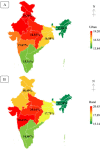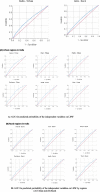Regional with urban-rural variation in low birth weight and its determinants of Indian children: findings from National Family Health Survey 5 data
- PMID: 37641012
- PMCID: PMC10464394
- DOI: 10.1186/s12884-023-05934-6
Regional with urban-rural variation in low birth weight and its determinants of Indian children: findings from National Family Health Survey 5 data
Abstract
Background: Low birth weight is a key indicator for child health, especially a concern in low-middle-income countries. However, health and medically-related reforms are being actively implemented in some middle-income countries like India. Identifying low birth weight (LBW) babies with their determinants across the whole country is essential to formulate regional and area-specific interventions. The objective of this study was to find out the burden and determinants of LBW on the regional and residential (rural-urban) divisions of India.
Methods: The present study was based on the NFHS-5 dataset (2019-21), a nationally representative survey in India. A total of 209,223 births were included in this study. A newborn weighing less than 2500 g was considered as LBW. According to the objectives, we used frequency distribution, chi-square test and binary logistic regression analysis for analysing the data.
Results: About 18.24% of the babies were LBW in India, significantly higher in rural areas than in urban areas (18.58% vs 17.36%). Regionally prevalence was more frequent in western (20.63%) and central (20.16%) rural areas. Regarding maternal concerns, in the eastern and southern regions of India, mothers aged 25-34 were less likely to have LBW children than mothers aged 35-49 years. It was found that the risk of LBW was more likely among the children born out of unintended pregnancies in almost all regions except for eastern part. In rural India, women who delivered children at home were more likely to have LBW children in India (AOR = 1.19, CI: 1.12-1.28, p < 0.001) and its central, northern, and southern regions than those who gave birth in institutions. The study indicates that LBW coexists with lower maternal education levels and poor household wealth index across all regions. About 58% and 57% of cumulative effects of independent variables on LBW can be distinguished in urban and rural India, respectively.
Conclusions: Targeted-specific strategies need to be undertaken as per region and geographical variations. Then only India should be able to decline LBW as proposed by National Health Policy.
Keywords: Birth weight; Public health; SDG; Under-five children; Wealth index.
© 2023. BioMed Central Ltd., part of Springer Nature.
Conflict of interest statement
The authors declare no competing interests.
Figures



References
-
- Bonnar K, Fraser D. Extrauterine Growth Restriction in Low Birth Weight Infants. Neonatal Netw. 2019;38(1):27–33. - PubMed
-
- Oudgenoeg-Paz O, Mulder H, Jongmans MJ, van der Ham IJM, Van der Stigchel S. The link between motor and cognitive development in children born preterm and/or with low birth weight: A review of current evidence. Neurosci Biobehav Rev. 2017;80:382–393. - PubMed
-
- Taywade ML, Pisudde PM. Study of sociodemographic determinants of low birth weight in Wardha district India. Clin Epidemiol Global Health. 2017;5(1):14–20.
MeSH terms
LinkOut - more resources
Full Text Sources
Medical

